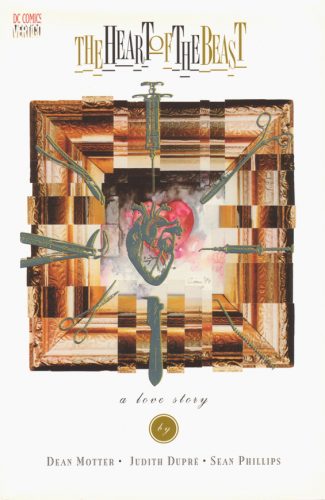 By DEAN MOTTER, JUDITH DUPRE, SEAN PHILLIPS (DC Comics; 1994)
By DEAN MOTTER, JUDITH DUPRE, SEAN PHILLIPS (DC Comics; 1994)
A one-shot comic from the always-enterprising DC Comics imprint Vertigo that was printed in an expensive hardcover edition. Vertigo’s higher-ups evidently thought a lot of THE HEART OF THE BEAST, and it is indeed a work of style and quality. I’m not sure, however, that it’s deserving of such an exalted presentation.
Written by Dean Motter (MISTER X) and Judith Dupre, and illustrated by Sean Phillips (JUDGE DREDD), it’s a fresh and decidedly adult refashioning of the Frankenstein concept for the 1990s. The setting is the suffocatingly pretentious NYC art world, where Dr. Wright, a hotshot plastic surgeon, operates a hip gallery.
In Wright’s employ is Victor, a strange man who receives periodic surgical treatments from the doctor. Weird though Victor is, he has his heart stolen by Sandra, a gorgeous blonde who tends bar at Wright’s gallery. Sandra herself is smitten with Victor, even though he’s extremely remote, has a medicine cabinet stocked with suspicious items, constantly rushes off on vague “business trips,” and has a violent temper.
As you’ve probably guessed, Victor isn’t entirely human but a Frankenstein monster creation. In fact, Motter and Dupre posit that Victor IS Frankenstein’s Monster, having escaped from the clutches of his master and relocated to New York, where he was taken in by Dr. Wright. Keep in mind the authors are working from Mary Shelley’s original novel and not the movie adaptations. That’s evident in the wistful romantic tone and the features of the monster, who looks nothing like Boris Karloff.
The authors were apparently attempting to trace some kind of connection between Mary Shelley’s 18th Century classic and the art scene of the 1990s, but it doesn’t quite come off. It’s as if Motter and Dupre wanted to script a horror story set in the art world and so plugged that aspect in, as it doesn’t feel integral to the piece. The plastic surgery connection, though, was good idea.
As for the artwork, it furthers the high class packaging with its impressive combination of impressionistic painting and photography. More evidence of outsized ambition can be found in the explicit references to Greek mythology, Rembrandt and of course Mary Shelley. It all adds up to a solid work of adult-oriented comic art, but the book can’t come close to living up to its own impossibly high aspirations.
